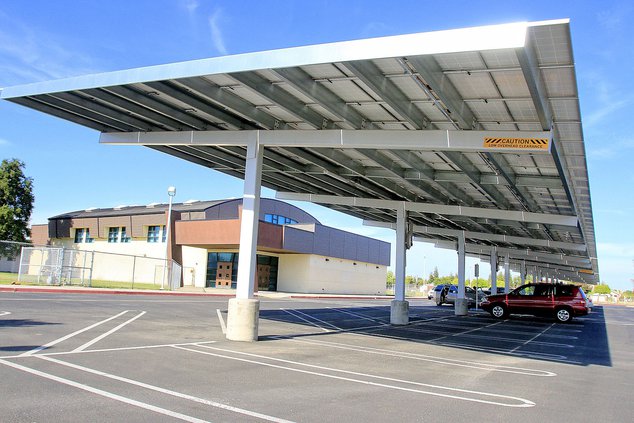A major solar installation at the municipal wastewater treatment plant designed to save ratepayers upwards of $3.8 million in power costs — more if PG&E rate hikes accelerate — may no longer be a sure thing.
After Mayor Ben Cantu Tuesday said he didn’t like the idea it would take Manteca 15 years or so to “make money” while Councilman Gary Singh said he wasn’t sure he favored tying up land immediately adjacent to the treatment plant he believes would be valuable commercial or at least a possible parking lot for the envisioned family entertainment zone, the council delayed making a key decision to keep moving the project forward until they meet again tonight at 7 o’clock at the Civic Center, 1001 W. Center St.
The city must sign a $1.3 million interconnect agreement with PG&E by Monday or else they will lose a window needed for construction work by the utility to allow the firm they have already signed a contract with — Borrego Solar— to design and construct the initial 2.5 megawatt project that could eventually be doubled.
The firm has already done work specific to the site and has solar panels in the pipeline to be manufactured and delivered.
Because the council had previously awarded the design and construct contract with directions to bring the solar plant on line, staff was unprepared to answer council questions regarding using another site or terminating the project.
Staff for tonight’s meeting was researching answers regarding how much money has been spent so far for work the council has already contracted to have done and whether that work can be transferred to another location. It is also not clear if another environmental assessment would be needed of a different site and if the project is delayed by the city and not the contractor whether there would be any penalties for ratepayers who are billed monthly for using the wastewater treatment system.
Solar projects — such as the ones installed on homes, commercial projects or even government agencies such as the Manteca Unified School District — are installed for the purpose of stabilizing electricity cost. Money that would have gone to PG&E instead pays off the solar installation. That effectively flat lines energy costs. Once the system is paid off or the investment recouped, the power the system generates is close to being cost-free.
Solar installations means
Manteca Unified PG&E bill
will increase only $1,049
this year compared to
$110 for a typical resident
How that works is illustrated by what Manteca Unified has experienced.
If you are a typical PG&E residential customer in Manteca you are going to end up paying $110 more for electricity in the 12-month period ending June 30, 2020 than in the previous fiscal year.
Manteca Unified School District with 37 campuses and almost 25,000 students will only pay $1,419 more in the current fiscal year ending June 30 than they did in the 2019-2019 fiscal year.
What seems like an improbability was made possible by the district’s decision more than six years ago to go solar.
Manteca Unified paid $2,189,585 to PG&E last school year after solar essentially flat-lined their annual energy costs.
To illustrate how the solar project has flattened district costs, the current budget has set aside $2,291,000 for PG&E payment. That’s only $1,419 more than last year.
Manteca Unified paid PG&E just $17,000 more for electricity in 2019 than they would have five years prior if they hadn’t installed solar at 25 of their 37 campuses plus the district office complex.
The first-year that all of the solar was in place was 2014. The value of the power Manteca Unified used — both solar generated and provided by PG&E — was the equivalent of issuing the for-profit utility a check for $2,172,790. The district paid PG&E $773,468.82 for electricity in 2014.
And while the MUSD just like everyone else isn’t immune from rate PG&E rate increases, not only are they not paying PG&E for the electricity that solar panels generate but they are also not paying more per kilowatt hour to generate electricity from their solar installations.
The means the PG&E push for a massive 12.5 percent rate hike to modernize its aging and dilapidated transmission and distribution lines to avoid causing wildfires such as the one the utility’s equipment did in Butte County in 2018 that killed 85 people, destroyed 14,000 homes and burned more than 5,000 other structures won’t hit the MUSD budget as hard as it would if the district had not installed solar.
The big advantage is essentially cost avoidance.
When the $32 million project was started in 2012 the conservative projection called for $48 million in district savings over 25 years.
The initial year of cost avoidance of $1.4 million has grown since 2015 to the point it is now pushing $1.8 million a year. The cost avoidance — general fund revenue — goes primarily to paying off the 15-year loans to install the systems. The rest of the savings is reflected in money that is not needed to pay PG&E bills that have been growing at a historic 4 to 6 percent annual pace since the dawn of the century.
The prospect a 12.5 percent hike in 2020 — and even more rate hikes designed to modernize the PG&E system and minimize wildfire threats — means the projected cost avoidance of $48 million over 25 years when the solar systems were installed is likely to soar past $60 million.





